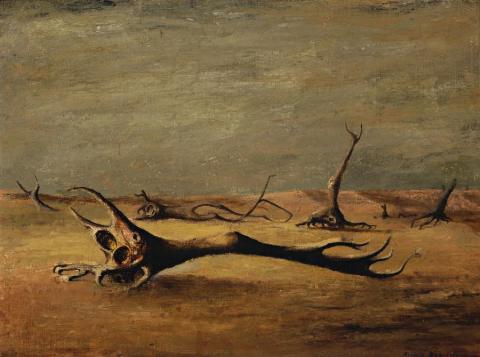WESTERN LANDSCAPE, 1945
RUSSELL DRYSDALE
oil on composition board
30.5 x 40.5 cm
signed lower right: Russell Drysdale
Hugh McClure Smith CVO
Thence by descent
Private collection, Sydney
Russell Drysdale, Macquarie Galleries, Sydney, 21 November – 3 December 1945, cat. 6, (as'Small Landscape', 'Kindly lent by H.A. McClure-Smith Esq.')
110 Years of Australian Art, Blaxland Galleries, Sydney, 1950 (as'Erosion Country') Russell Drysdale Retrospective 1937–1960, Art Gallery of New South Wales, Sydney, 5 October – 6 November 1960, cat. 43 (as 'Western Landscape', lent by 'HisExcellency H.A. McClure Smith, CVO, Rome, Italy', label attached verso)
Burke, J., The Paintings of Russell Drysdale, Ure Smith, Sydney, 1951 (as 'Landscape with Tree Forms' and illus. as 'Western Landscape', unpaginated)
Dutton, G., Russell Drysdale, Thames and Hudson, London, 1964, pl. 35(illus. as 'Western Landscape')
Russell Drysdale's Australia, Ure Smith, Sydney, 1974, p. 21 (illus. as 'Western Landscape')
Klepac, L., The Life and Work of Russell Drysdale (rev. ed.), Sydney, Murdoch books, 1996, p. 261, pl. 75 (illus. as 'Western Landscape')
Smith, G., Russell Drysdale 1912–81, National Gallery of Victoria, Melbourne, 1997, p. 95 (referred to as 'Small Landscape')
Small Landscape, 1945, oil on composition board, 30.0 x 40.5 cm, Bonhams & Goodman, Melbourne, 6 May 2009, lot 41
The humanism of Russell Drysdale's art and its compelling authenticity of vision come from his experience of the land and its peoples. Close identification with the land appears early in his art, allied to his intriguing extension of the concept of mateship. Gaunt, stick-like figures in Man Feeding His Dogs 1941 (Queensland Art Gallery, Brisbane) echo in the trees. In Woman in a Landscape 1949 (Art Gallery of South Australia, Adelaide) the figure's bulk gives image to the stoicism of survival in a landscape of hardship. When Aboriginal figures are present, the relationship moves to a deeper level of integration and interpretation. They become one, as in The Rainmaker 1958 (private collection). By merging figure and surroundings, Drysdale emphasises the complete connection between man and his environment. Earlier, in his drought paintings of 1945, Drysdale's art underwent a dramatic change through his unique metamorphosis of the landscape.
In late 1944, Australia was in the grip of a devastating drought. Drysdale and journalist Keith Newman toured the far west of New South Wales, reporting on its impact for the Sydney Morning Herald. Drysdale's sketches illustrated Newman's subsequent articles. The affecton Drysdale was so profound that he decided to produce a series of paintings, exhibited at the Macquarie Galleries, Sydney in November 1945. Western Landscape (exhibited as Small Landscape)1 was one of this brilliant collection of seventeen acclaimed paintings including Walls of China, Gol Gol purchased by the Art Gallery of New South Wales, Sydney, Joe Resting acquired by Warwick Fairfax (now Art Gallery of Western Australia, Perth), and Red Landscape acquired by Sir Keith Murdoch. Two alike paintings were titled Small Landscape, one being lent by R.A. Henderson and the other (the work on offer) by H.A. McClure Smith, editor of the Sydney Morning Herald and friend of the artist. By uniting pitiable suffering through the metamorphosis of elements of the landscape into human form, Drysdale imbued these distinctive paintings with a heart-rending poignancy. The agonies of drought are felt more passionately through the figural references of twisted roots and voids, skeletal in a grey or often blood red sky. It is the stuff of epic tragedy, handled in like form. In Western Landscape, a balletic tragedy of surreal intensity, the dramatic presentation of the foreground tree recalls the image of the fallen hero. Sometimes referred to in literature to as a broken shaft or fallen column, it brings to mind Tennyson's memorable lines from Morte D'Arthur - 'So like a shatter'd column lay the King.' The painting's battlefield of drought is strewnwith further slain, pleading arms and claw-like fingers skyward reaching in vain. The idea is continued in Desolation 1945 (Castlemaine Art Gallery and Historical Museum, Victoria) with the significant addition of the remnants of a 'sacked' dwelling. In another related painting, Crucifixion 1946 (Art Gallery of New South Wales), the crucified land is given a Christian image.2 Anthropomorphism reaches its height in The Rabbiters 1949 (National Gallery of Victoria, Melbourne), the fallen tree a forearm torn from the body, land forms revealing the human torso. For Drysdale, the bones of the landscape lay in the ancient rocks of our timeless land with past and present in living harmony.
1. Traditional curatorial practice requires the use of the title under which the artist first exhibited the work. In the case of this painting, however, Drysdale changed his title from 'Small Landscape' to 'Western Landscape', as it appeared thereafter in exhibition catalogues and monographs on the artist. This provided better identification, distinguishing it from the same titled, companion painting in the 1945 exhibition, acquired by R.A. Henderson.
2. Crucifixion was once also in the collection of H.A. McClure Smith.
DAVID THOMAS
